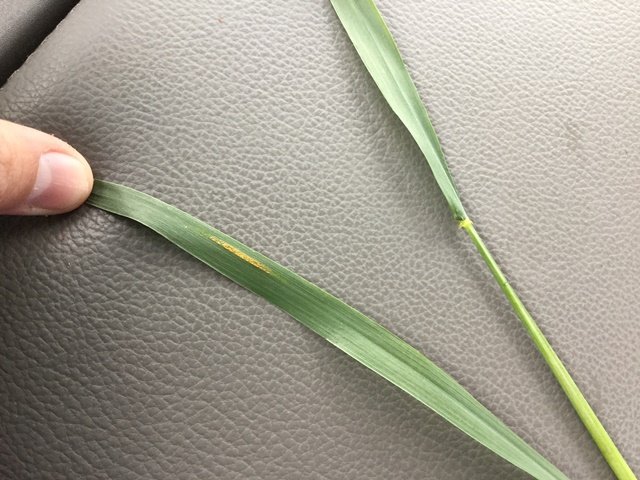Murphy's Wheat Law
 Unfortunately, for wheat grown in southeast Kansas, Murphy’s Law (Anything that can go wrong, will go wrong) tends to be the norm. Due to our environmental conditions, wheat diseases tend to thrive. However, with proper management, wheat can be a successful crop for producers.
Unfortunately, for wheat grown in southeast Kansas, Murphy’s Law (Anything that can go wrong, will go wrong) tends to be the norm. Due to our environmental conditions, wheat diseases tend to thrive. However, with proper management, wheat can be a successful crop for producers.
I have had the pleasure of checking the southeast Kansas Variety Performance Trials at the Parsons Research Station on a regular basis since the end of February. Very early on, it was apparent that a fairly heavy infestation of aphids had settled in the trials. Due to this, there has been an abundance of Barley Yellow Dwarf Virus (BYDV) in the plots.
The best management practice for BYDV is definitely genetic resistance. Unfortunately, the levels of resistance available amongst varieties are simply not that high. Case in point, the most common variety planted in not only southeast Kansas, but the entire state, is Everest. Everest is the most BYDV resistant variety available but only rates as a 4 on the 1 (resistant) to 9 (susceptible).
While virus diseases seem to be at a high level this year, fungal diseases are also present. The most worrisome is probably stripe rust. In general, it is recommended to pay attention to the levels of the disease in our neighbors to the south. If Oklahoma and Texas have low levels it is usually a good sign for us.
Unfortunately, Murphy struck this year when it comes to stripe rust. Oklahoma and Texas did not report high levels of the pest. However, the fungus has arrived in southeast Kansas and is heavy enough in spots to require attention. Once again, genetic resistance is one tool farmers can use. However, the earlier mentioned Everest is very (VERY!) susceptible to stripe rust. If a producer has susceptible varieties, the best management practice is the use of fungicide. The rule-of-thumb is a ten percent savings in yield so producers must critically evaluate their fields to justify spraying.
While I freely admit this is strange to say, stripe rust is much easier to manage than our next pest: fusarium head blight (a.k.a head scab). In stripe rust’s case, producers can wait and see if the pest is in the area before they must make the decision of whether or not to spray. That is not the case when it comes to scab.
The decision to spray must be made before producers are even sure if their crop has been infected. Once again, the southeast Kansas environment and most common crop rotation create an unfortunately ideal situation for scab. The same fungus that causes scab in wheat causes stalk rot in corn. Thus, in the corn-wheat-double crop soybean rotation, planting wheat following corn increases the likelihood of a scab infestation.
Another important factor that increases scab infections is high relative humidity (80%) at the time of flowering. Unfortunately, the weather this year seems to be indicating that scab could be an issue. Once again, the best management practice for scab begins with genetic resistance. Everest has as good of resistance as is available and it rated, once again, as a 4.
Again, there are fungicide options available to producers if they choose. It must be pointed out that producers need to read and follow the label instructions, paying particular attention to the pre-harvest interval. With growth stages in our area ranging from just heading to completely flowering (or even past this), fungicide options may be limited.
As with most fungicide applications, timing is imperative, though with scab, it may be even more important than other pests. The window for application to suppress scab is relatively short at approximately 7 days after flowering. If conditions are favorable for the disease and the variety is susceptible, spraying may be justified.
In addition to these fungal pests, there have also been reports of septoria leaf blight, tan spot, and some fairly heavy infestations of powdery mildew. We do not tend to worry about these fungi unless they reach the flag leaf. Thankfully, the fungicides that farmers may choose to spray on rust or scab are, in general, fairly effective against these pests as well.
Hopefully, producers have avoided Murphy’s Law in their wheat this year. If you have questions or would like more information, please call me at the office (620) 724-8233, or e-mail me at jcoltrain@ksu.edu, or visit the Wildcat Extension District website at www.wildcatdistrict.ksu.edu.
Contact:
Josh Coltrain
Crop Production and Local Foods Agent
Wildcat Extension District
jcoltrain@ksu.edu
(620) 724-8233
K-State Research and Extension is an Equal Opportunity Provider and Employer
